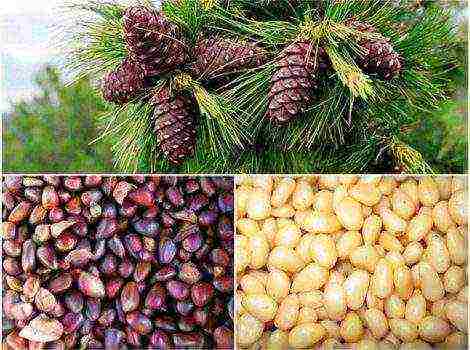Content
- 1 Medicinal properties and characteristics of wild pear
The medicinal properties and characteristics of wild pear
Autumn is not only a great time for walking in the autumn forest, but also a time for picking healthy fruits. Ask what kind of fruit can you pick in the forest? Wild pear is a tree with small fruits, but with unique beneficial properties.
Description of pear Dichka
Wild pear or common pear is a wild tree. The bark of the tree is gray, the crown is dense. Fruits are green or yellowish in color, round, stick to the stalks. Blooming in April. Ripening occurs in the first half of September. Fruiting begins from the 8th year of the tree's life.
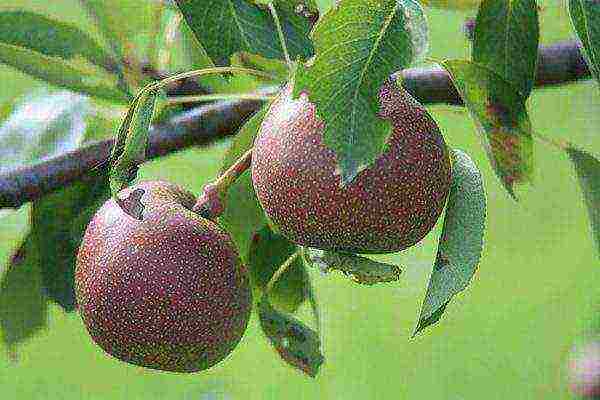
You can meet the common pear in the forest belts of Russia, in the south of Ukraine, Armenia, and Europe. During the flowering period, an unusual sweet aroma comes from the tree, which attracts insects. In autumn, ripe, red-sided fruits are inedible, since the pulp is rough, one might even say stony. In order to start eating fruits, they must lie down... The fruits are stored for more than three months. The harvest from an adult tree can reach up to 40 kg.
The plant grows both singly and in groups. The wild pear is not a finicky tree that develops a strong root system in nutrient soils with neutral acidity. Propagated by seeds and root shoots. Mostly you can find abundant pneumatic growth.
The wild pear advantage - This is a vigorous stock, which can be combined with cultivated varieties. The wild tree grows in partial shade and in sunlit areas. In cultural conditions, it is better to plant a pear near the forest.
Advantages and disadvantages, medicinal properties and contraindications
The advantages of a wild pear include the following:
- A healthy fruit that has excellent medicinal properties. The broth can lower the temperature, the pulp has a diuretic effect.
- The composition includes tanninsthat have a beneficial effect on the digestive system.
- Contained natural antibiotic, which is able to stop inflammation.
- Fetus has a bactericidal effect.
- Baked pear benefits in the treatment of the upper respiratory tract.
- You can use boiled, dried, baked and fresh.
- Tree in spring is an early honey plant.
- The wood of the tree is used in the carpentry shop, thanks to dense and valuable wood.
- Plant bark used for dyeing wool, carpets.
- Fruit is beneficial affects men's health.
- Fruits are rich in vitamins A, B1, B2, E, P, PP, C, folic acid, a number of useful metals, macro- and microelements.
- Frost resistance.
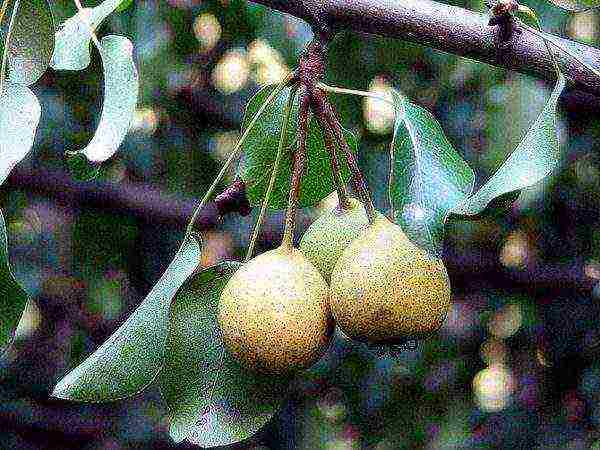
Wild pear contraindications:
- Categorically it is forbidden to eat on an empty stomach.
- It is forbidden drink water.
- After eating a pear, it is not recommended to eat meat products.
- Do not eat green fruits.
Features of planting seedlings
Wild pears are planted as field-protective plantings, but you can also plant it at their summer cottage. Unlike other varieties, this type of wild plant tolerates severe frosts and does not need shelter.
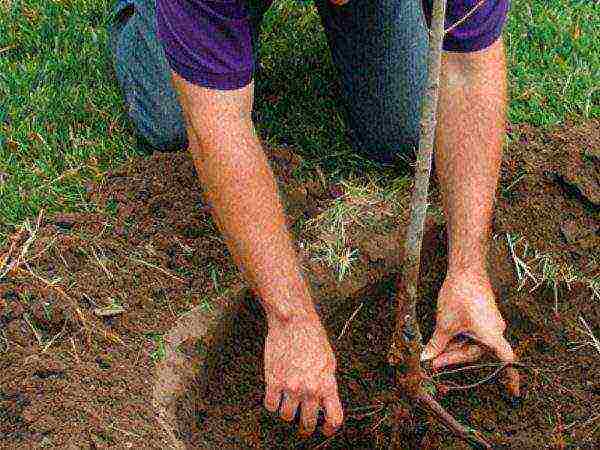
The plant is wild, so in cultural conditions it is better to place it near a deciduous forest.It is necessary to choose a place for landing that is illuminated. The tree is suitable for fertile soil with neutral acidity. It is recommended to water fragile trees more than an adult plant.... Blooms in April, but may bloom later depending on climatic conditions. Reproduction is done by grafting or grafting, but you can also try seeds. When choosing seedlings, choose young trees with a well-developed root system. The most optimal time for planting a young seedling is autumn. In the spring, you can plant after thawing the soil.
Conditions for growing wild pear
Everyone knows that the right place for a plant is the key to a rich and healthy harvest. therefore choosing a seat is considered an important step in landing... It should be sunny and sheltered from the winds. Once you have decided, start preparing the landing pit. It must be dug out in advance, its dimensions: width and depth of at least 1 m. Only young plants are planted in the ground, which do not have damage, diseases and they have a powerful root system. Planting can be spring and autumn., but it is better to plant a pear in the fall - in the middle or end of September, when the foliage of the seedlings has fallen out and sap flow has stopped.
The pits were dug, the seedling was picked up, we begin to plant. A stake is driven in a hole from the center at a distance of 30 cm, which is necessary for the support and proper growth of a young seedling. Manure, superphosphate, potassium salt are added to the bottom of the pit and mixed with the ground. Shake the pear seedling, straighten the root system and set it in a pit, gradually covering it with earth. The root collar should rise above ground level. The last step is to compact the soil around the tree and water... Watering is required in moderation if there is no drought.
A young seedling can begin to bear fruit only in the fourth year of life.but this may depend on soil and climatic conditions. Flowering occurs in April, harvesting in the second half of August.

Tree care in autumn
Throughout the warm period, the tree was taken care of: watering, treatment from pests, now it is necessary to properly prepare the tree for cold and frost.
- The most important step will be crown trim.
- Insecticide treatment for diseases and pests, which can persist during the cold weather in the bark of the tree, then in the spring they will begin to be active. It is better, after all, to prevent the reproduction of pests and diseases, than to wage an active fight with it later.
- Fertilizing should be carried out in early autumn.
- Digging and deep watering near-trunk circles.
Harvesting and storing crops, the benefits of dried fruits
Fruits are medium in size, ovoid, covered with a thin, but rather dense, rough skin. At the stage of picking, the fruits are greenish-yellow, well-ripened pears of golden-yellow color. The pulp is yellowish, with a sweet and sour taste.
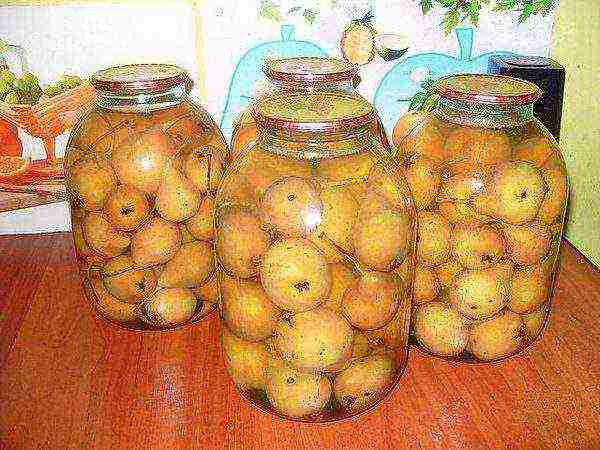
The fruits retain their appearance and taste for six months... A tree can yield more than 20 kg of harvest per season. It is recommended to use the fruits fresh, dried and canned. They can be used for making desserts, juices, wine drinks. Compotes are made from dried fruits.
Features of this variety
- Plucking wild pears from the tree, stored in a warm placewhere they ripen. During this time, the pulp turns yellow, loses its firmness, becomes sweet.
- Wild pear fruits are much healthier and richer in active substancesthan conventional varieties. Due to the high content of vitamins, trace elements, minerals, the fruit has disinfecting, tanning properties.
- Pear wood is highly valued in the production of first-class furniture... You can cut it in all directions, removing layer by layer gradually with a chisel.
Diseases and pests, treatments
Leaf gall midge - a dangerous pest of pear, which is a brown insect. The larvae are laid by insects and eat leaf tissues. This leads to outgrowths, the leaves become brittle, yellow and curled. The problem can only be dealt with with insecticides or mechanically. Collect twisted leaves and destroy, be sure to dig up the soil under the trees in the fall.

Medianitsa - a small pest that damages the tree. The insect secretes sticky excrement, which inhibits the development of the tree. The fruits take on an ugly shape, the branches dry out, and the plant weakens. You can protect the tree. To do this, be sure to plow the soil, remove fallen leaves. It is necessary to spray the pear with insecticides (metaphos, ambush, decis).

Scab - affects leaves, fruits and shoots. The infected tree begins to bear fruit poorly, the yield decreases several times. You need to fight dramatically. The tree is sprayed with urea solution or ammonium nitrate solution.

Wild pear is common in appearance and taste. but it has a dignity - these are medicinal propertiesthat contains the fruit. Therefore, such a tree can easily replace a pharmacy.

